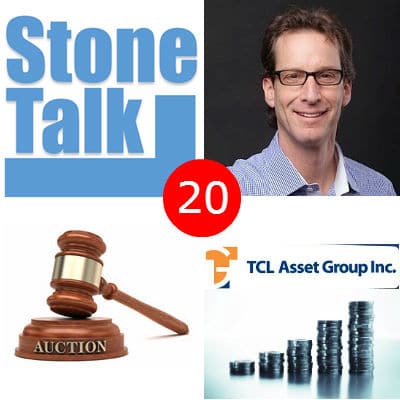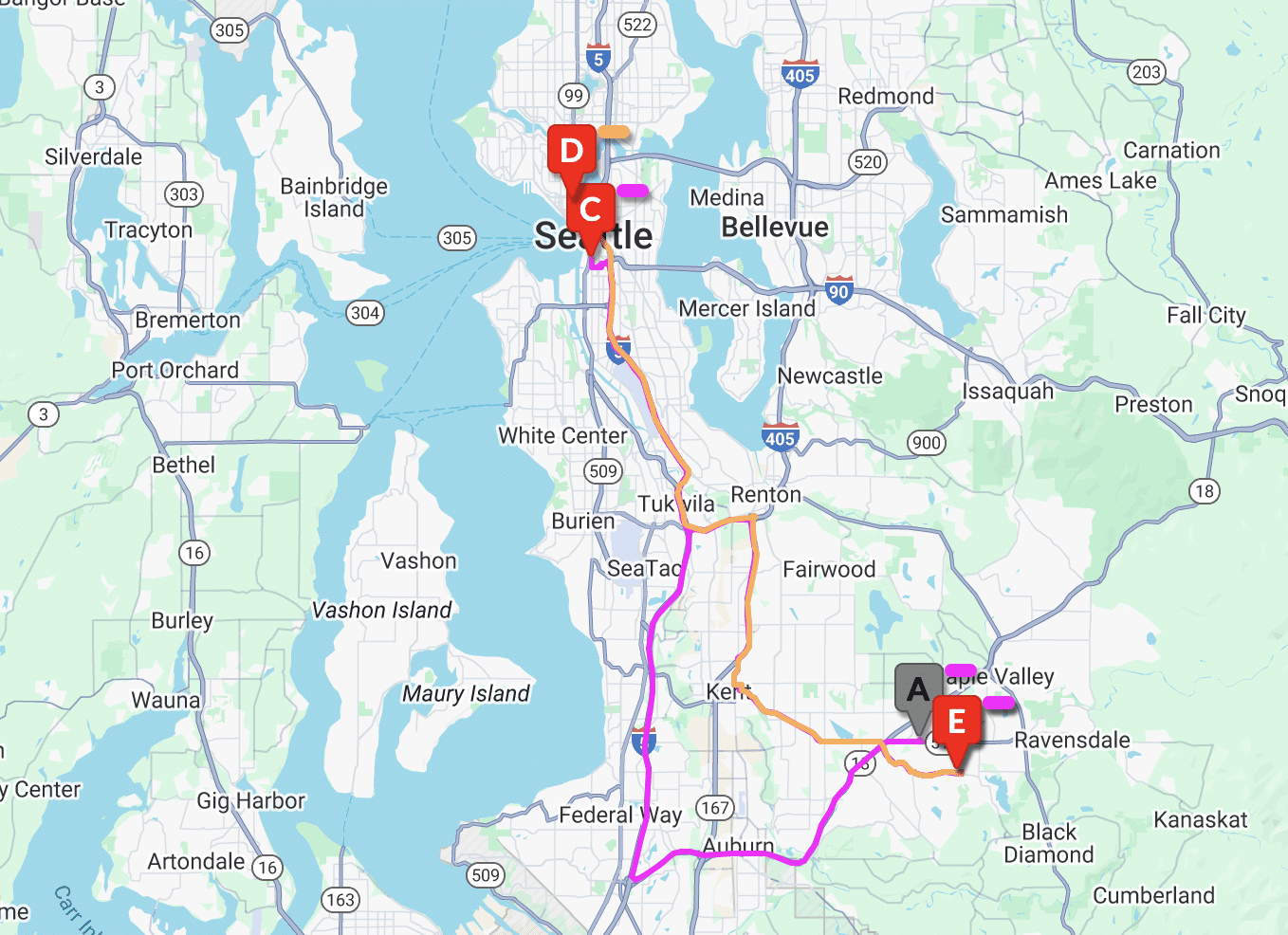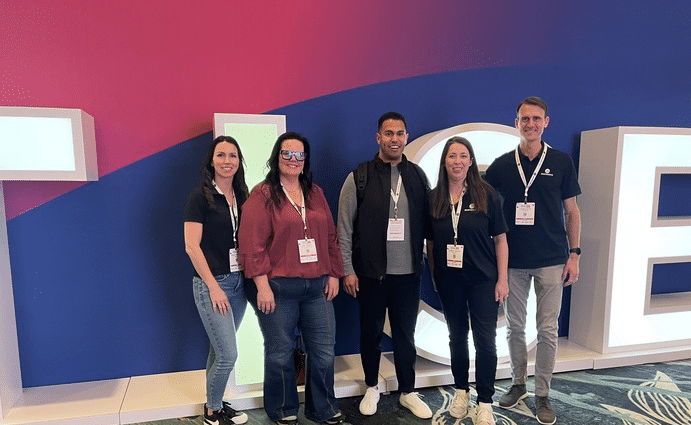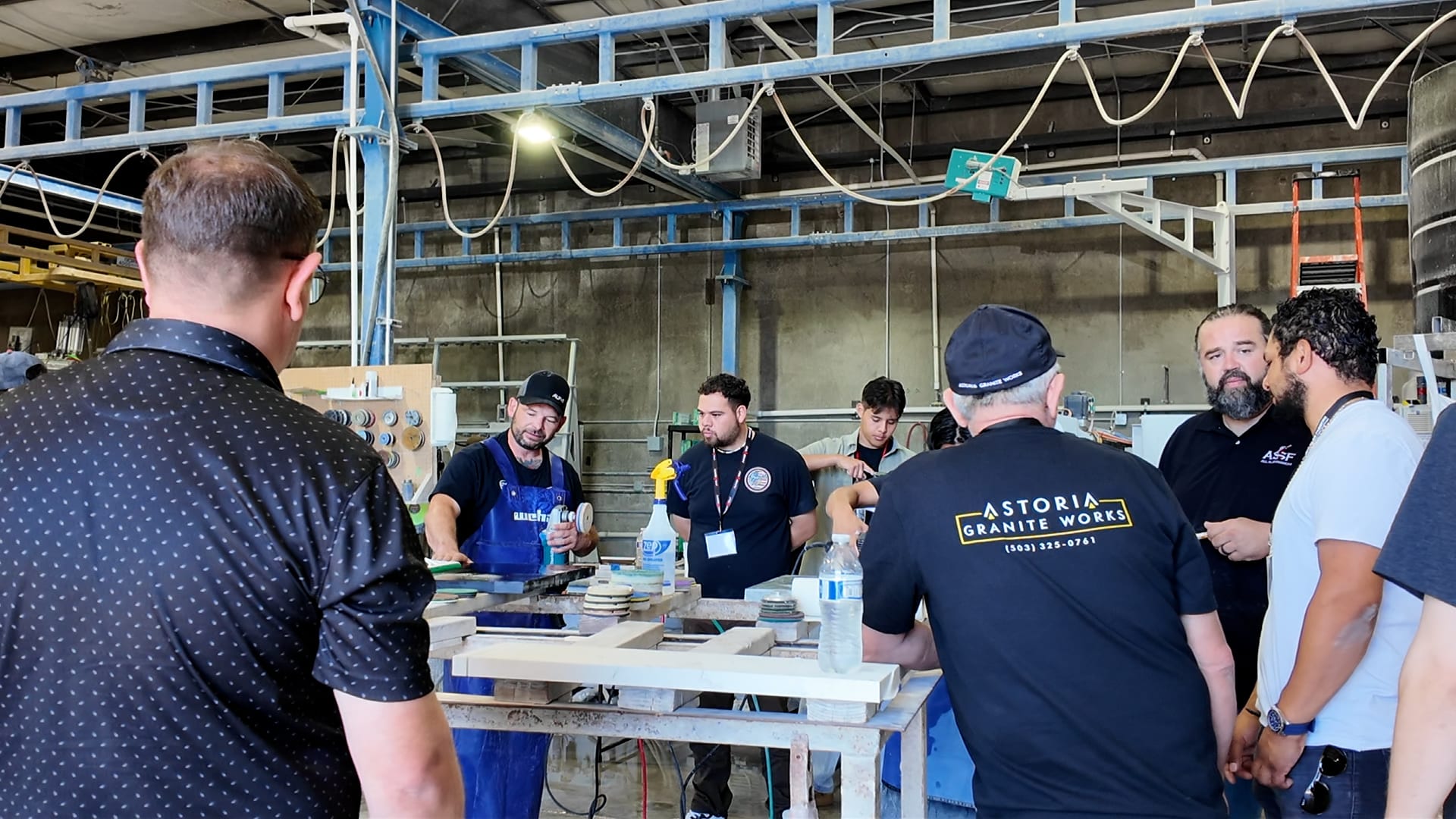In episode 20, Patrick speaks with Terrance Jacobs of TCL Asset Group.
Listen to this episode to learn:
- 8/5/2015 Auction of Breton equipment and lots of Cambria
- Why you should get your equipment appraised
- The difference between a business valuation and asset audit
- Red flags to look for when purchasing machinery
Be sure to subscribe to the podcast in iTunes… and please let us know what you think! You can leave comments for this show on the StoneTalk Facebook page or on this site.
If you have stories or insights that you’d like to share with other fabricators, please reach out to Patrick.
Transcript
Patrick: Welcome to StoneTalk, the podcast for countertop fabricators. Brought to you by Moraware, makers of JobTracker scheduling software and CounterGo estimating software for countertop fabricators. I’m your host, Patrick Foley. Today, I’m chatting with Terrance Jacobs from TCL Asset Group. We’re going to talk about some equipment and material they’re auctioning off, and then we’ll talk about managing assets in general. Let’s give him a call.
Terrance: Hello?
Patrick: Hi, Terrance. It’s Patrick from Moraware. How are you?
Terrance: I’m great, Patrick. How are you doing?
Patrick: Good. Let’s jump in and talk right away about the auction you’re having. What are you auctioning off? When is it, and where is it?
Terrance: So we recently purchased the assets of a company called Stratech, which is located on the south shores of Montréal, about an hour just south of the airport in Montréal. It was a very high end, fairly new fabricating facility, and they were working with quartz, marble, and granite.
Patrick: Okay. And what kind of equipment do they have? Was it Breton machinery, I believe?
Terrance: Yeah. We’re going to be offering for sale three Breton CNC, one waterjet cutter. It’s 2010, really nice waterjet cutter. It’s a combination diamond saw and waterjet stone cutter. A Breton CNC stone router, a 2011, and a 2007 stone router. The highlight of the sale is actually, hopefully, going to be the Comandulli automatic multi-spindle polishing machine, which is a 2014. They just installed it at the end of last year. And really, actually that Comandulli, it’s the only one available in North America.
Patrick: Oh my.
Terrance: I actually spoke with Comandulli about two weeks ago, the distributor for Comandulli in North America, and he doesn’t even have one of them in stock right now. So if you’re looking to buy one of these polishing units right now, I’m the only one that has it.
Patrick: And that’s August 5, right?
Terrance: Yeah.
Patrick: You can see it August 4. Is that correct?
Terrance: Yeah, the inspection is August 4, or you can also have a private inspection. If you call us, we can make arrangements for that. But the auction is August 5, yes.
Patrick: That’s 2015. So if you’re listening after this, it’s probably too late. And you also have a bunch of Cambria, like 2000 slabs, right?
Terrance: Yeah, we have 1600 offcuts of Cambria product, and we have 430 full slabs available for sale that we’re going to be putting on the auction block, too.
Patrick: Cool. And I sent you a link. Did you check out RemnantSwap or no?
Terrance: I did. I checked it out. And actually, about 10 minutes after we chatted on the phone, I got someone in my office to post what we have available for sale.
Patrick: Nice.
Terrance: Yeah, it looks like an interesting website. And I’m sure we’ll get some interest in the short term.
Patrick: But by August 5, it’s all going to be gone, right? So are you auctioning all that off as one lot or you’re breaking it down by color? Or how are you going to get rid of the material on August 5?
Terrance: Yeah, that’s a great question. The full slabs we’re probably going to auction off as one lot. I don’t think we’re going to be very particular in auctioning each individual off. So we’re going to do the full slabs as one lot, and we’re going to do the partial slabs as one lot also.
Patrick: Interesting. All right.
Terrance: Yeah. Really our buyer is for a fabricator and not just someone looking to do their own counters or something.
Patrick: Right. So where do people go for more information if they want to check this out?
Terrance: If you want more information about the upcoming auction on August 5, you can go to our website which is ManagingYourAssets.com, or you can Google up our company named TCL Asset Group, and that will take you to our site.
Patrick: Cool, thanks. All right. Now, since I’ve got you on the phone, let’s shift the conversation to assets in general, okay? You just mentioned your name, TCL Asset Group, and your website, ManagingYourAssets, so I assume you have something interesting to say about assets. For context, why don’t you just start by describing what your business is and what you do for manufactures and for other stakeholders?
Terrance: Sure. Our company started in 1958 by my father, actually.
Patrick: Cool.
Terrance: And we have three divisions. The first division is our appraisal division. So let’s say, for example, you’re a fabricator and you’re looking to buy maybe that Comandulli that we’re selling next month, and you’re looking for financing, you would have us come into your facility. We would evaluate all the equipment that you have, and then we would put together a certified appraisal report, which you could then take to one of your lenders to get money on to purchase new equipment. So that’s our appraisal division. And we not only do that for someone that’s looking to get a loan or to put together a lease agreement, we also do it at the backend. So if a company is going bankrupt, and a trustee or a lawyer or a family member wants to know what the assets are worth, we’ll come in and evaluate their assets. So that’s our first division.
The second division that we have is a sales division, which takes us to this auction. So what we do is we buy manufacturing plants, not only in the fabrication of countertops. We do it in oil and gas industry, woodworking, metalworking, pharmaceutical, chemical. And we go in and we buy assets from owners, and then we sell them either by auction or private negotiated sale. And sometimes, we also work on a commission basis, where you might hire us to sell your assets on a commission basis.
And our third division is a real estate division, where we offer for sale real estate by using the auction method rather than traditional ways of marketing and advertising real estate.
Patrick: Cool. And what geographies do you cover? Are you limited to part of North America, or all of North America? What do you cover?
Terrance: Yeah. Well, pretty much most of our work is in the Western Hemisphere. So we have jobs in Canada, in the U.S. We’re doing some work in Puerto Rico right now. We’ve done a lot of work in Mexico. We’ve done work in some of the mines in Chile. So I would say, for us, we’re selling out of the Western Hemisphere, and our market is the world. We never consider, for example, the sale that we’re having just outside of Montréal, we’re not just going to advertise locally to that market. We’re advertising worldwide.
Patrick: Very cool. And so let’s say I have a thriving fabrication business and I love what I’m doing. I don’t intend to sell, and I don’t necessarily intend to buy anything anytime soon, but I have hundreds of thousands or even millions of dollars invested in equipment. Do I need to care about the actual value of that equipment compared to what I’m depreciating on my taxes? Do I even care in that situation or no?
Terrance: Yeah. Well, definitely. For one thing, you’re going to want to know for insurance purposes what your assets are worth so you could put the proper insurance. And we’re also called many times to do replacement value appraisals. So that’s for one thing. Also there’s standard depreciation, accounting depreciation, but that’s very different than the appraisal approach because we use the sales comparison approach. Instead of just saying every year, a piece of equipment is going to depreciate by 5 or 10%, we go out into the market and we look at similar or the same items and see what they’re selling, and that’s how we determine what the asset is worth.
So definitely, people like to know what their assets are worth for insurance reasons. And in many cases, dealing with a bank or a leasing company, you want to pledge assets that you have that are already paid off to improve the manufacturing end of your company. So that would be another reason why you’d want to know the value of your assets.
Patrick: So if I want to buy new equipment, what’s the best way to pay for it? Should I get a loan even if I don’t need one? Or is it more contextualized that well, if I can pay for it out of profits, I should do it that way instead. What’s your opinion?
Terrance: That’s a million-dollar question. My father always told me that you should never get money lent to you. But I use credit cards all the time, because if someone’s going to lend me money for free for one month, I’m going to grab it. It really depends. Some people like to just pay for the equipment and know that they own it. But it’s very difficult to grow your business if you’re always paying down or buying your equipment right out, because you’re using that capital where it could be used somewhere else. So it’s a loaded question that’s difficult to answer, but from what I’m seeing, a lot of people are pledging equipment to purchase new equipment and they’re succeeding in building their company.
Patrick: Is it easier to get a loan based on the value of the existing equipment I have versus other aspects of the business? Is that a more straightforward loan or have better terms in other ways, or does it depend?
Terrance: Yeah, well, it’s definitely when you’re lending money on equipment, it’s something that’s tangible and something that can be resold right away. The other area a bank or a leasing company is going to look at is if you own your own building or you own the land. So really, a company will pledge the building and the land and some equipment.
Patrick: Okay. And then if you don’t have any of those and you’re going on your ability to do business in future profits and things like that, you’re not going to get as good a term, although you may be able to make it work.
Terrance: Exactly. If you’re just going on your receivables, it’s difficult to get money. It’s a lot easier to pledge something that’s tangible that can be resold right away, definitely.
Patrick: And so it tends to be expensive equipment, a quarter of a million dollars for a new water saw or CNC, that sort of thing.
Terrance: Sure.
Patrick: As a growing fabricator, how do I know if I can even afford that? At what point do I know, “Okay, yeah, it’s time to . . . certainly a bank’s going to give me money on this.” Or do you have a rule of thumb, if you were giving advice to a client, a simple ratio that they can look at to say, “Yup, now’s the time to invest more money and equipment”? Or is it just you have to do the work of figuring out on a case-by-case situation?
Terrance: Yeah, it would be case-by-case. I’m not a business evaluator, so I can’t say. I don’t go into a company and look at how their business is run, and if they’re making money, and how much they’re making money, and what their future forecasts are, and that kind of thing. It doesn’t matter to me. It doesn’t matter to me how much money that piece of equipment can make, because I’m not looking at the value that way. I’m just looking at what it would sell in the market.
Patrick: Interesting.
Terrance: So it’s difficult for me to answer that question.
Patrick: Well, but that itself is an interesting answer because a business owner does have to ask, “What can the value of this equipment make for me?”
Terrance: Right.
Patrick: That’s the question a business owner has to ask, but it’s useful then to compare that to who else is going to care about this equipment? What other value does it have?
Terrance: Right.
Patrick: Particularly, let’s say, you’re thinking about retiring in a couple of years. If you’re growing your business, you’re thinking about what value it can make you going forward. If you’re looking at shutting down your business, that’s certainly a time you would absolutely be thinking about, “Well, what can I sell these assets for?”
Terrance: Yeah, that’s a really good point. And the bank, obviously, is going to look at what your sales are and what your projections are and so forth. But, yeah, the easiest way that I describe what I do is . . . how it’s different than a business evaluator is you take a taxicab. Now, I look at a taxicab as what kind of car it is, if it’s got air-conditioning, what the kilometers are, how the servicing has been, and what color it is, and what kind of engine’s underneath the hood. Whereas a business evaluator is going to look at how much the taxicab can generate in one day.
Patrick: Interesting. That’s the gist of the difference there.
Terrance: Yeah.
Patrick: And so what’s an asset audit and how’s that different from an appraisal?
Terrance: Well, an asset audit is something that we do when someone wants to get a good listing of equipment that they have on site. Because many times, I get a list of equipment from a company, and it just says, “one polishing machine” or “one saw”. It doesn’t say anything else. So if a new company is being formed and they bought a bunch of equipment and they want to have a good asset registry of everything that they own, we’ll come in and do an audit of their facility. We won’t actually evaluate each piece of equipment. We’ll just come in, and we’ll look at the machine, and we’ll put down what the make is, what the model number is, what the serial number is, any type of attachments or improvements that they’ve had on the machine, and any accessories that the machine has. And we list that all out. And then from there, they have a proper listing of the equipment that they can use either for insurance purposes. Or they can go to the bank just as an initial introduction to what they want to do if they want to receive money and get a loan or get a lease. So that’s what an asset audit is.
Also for banks, on the other side of the world, for banks, when a bank has lent money to a client, they will have us come in every year to do an asset audit. So we’ll actually have our list, we’ll go back into the company. We’ll look at each piece of equipment and make sure it’s still there and make sure it’s so operational, and then report back to the bank what we’ve seen so that the bank knows that what they’ve lent money on is still secured and still in place.
Terrance: Well, that makes sense. I never thought of that, but I can certainly see why a bank would care about that.
Patrick: Yeah. Yeah, definitely. Because especially when there’s many banks involved and they’re lending money on similar or the same items. So, for example, a forklift truck. A company could have 20 forklift trucks, and that’s divided by seven different banks who own different forklift trucks. Now, if they’re all yellow and they’re all Mitsubishi 250s, and they’re all propane, without the serial number, how are you going to really know which one is yours if you had to repossess them? So that’s why an audit is also helpful.
Patrick: Very interesting. And do you use any special technology for that, or it’s just a Word doc or an Excel doc or something like that?
Terrance: Yeah. Pretty much we go in, we look at the piece of equipment, we walk around it, and we just write the information down. We are getting into other things now with scanning barcodes and different things like that to facilitate the information and get it quicker to our clients.
Patrick: Interesting. So just to wrap up here, and again, part of the reason we’re doing this interview is just you’re selling stuff that some of our listeners are going to care about. Hopefully, there’s a connection there. But also, you have knowledge that is interesting and not necessarily a point of view that our customers think about every day. So in just a general, chin-stroking sense, what are some common mistakes you see that manufacturers make, particularly with their assets that you see, or just in general, that make you shake your head and say, “Boy, I don’t understand why manufacturers do blank”? Anything like that that you . . . any advice you could give?
Terrance: Yeah, sure. Sure. I should do a presentation. So there’s a few red flags that come up all the time.
Patrick: Really?
Terrance: And I’m usually discussing this with the lender, saying to them, “When you go see a client, this is what you should look out for.” One of the main things is the date of purchase as opposed to the date of manufacture, okay? So when you’re looking at a piece of equipment and someone tells you that they just purchased it, many times you assume that it’s brand new.
Patrick: Okay.
Terrance: Okay? When really, it might have been manufactured or made 15, 20 years ago. So that’s something to consider, maybe for the listeners out there, is when you’re going to buy a piece of equipment and it says a 2014, you better make sure that the 2014 means it was made in 2014 and not purchased in 2014. So that’s definitely something to look out for, right? So the year of manufacturing versus the purchase date, those are two different things. And many times you assume that when someone buys something that they bought it brand new.
Also, when you’re buying equipment, maybe you should look at if it was repainted or not. If you go look at a piece of equipment and it’s really, really shiny and beautiful and there’s no scuffs on it, you might want to question, if it’s not a newer piece of equipment, why it looks that way. So that’s definitely . . .
Patrick: So you’re saying if it’s shiny, that might be a worse sign than if it were just scuffed up and used?
Terrance: Yeah, exactly.
Patrick: Like someone might be hiding something?
Terrance: Yeah, for example, this sale that we’re doing, the stonework industry is messy. There’s a lot of water. It’s messy. And the piece of equipment that we’re going to be selling, we’ve hardly done anything to them. We might have rinsed them down, but that’s it. Because we want people to see what the piece of equipment looks like and what condition it’s in, which also fares better on the side of us. Because if it was not well-maintained, the equipment, it will show really well, but at the same time, will show usage.
Patrick: So just look for assets that reveal their own truth, good and bad.
Terrance: Yeah.
Patrick: But if something’s repainted, it might be someone trying a little too hard.
Terrance: Exactly. And I guess the last thing for the listeners is to consider the leasehold improvements that are going to be involved in when you’re purchasing new equipment. So what I mean by that, it’s one thing to purchase a piece of equipment. But if that piece of equipment needs certain power going to it, if it needs larger transformers, or a substation, or if a pit needs to be built so that a piece of equipment can be dropped into it, these are all things to consider. Because at the end of the day, like you said, you’re spending $350,000 on a new machine. You don’t want to be spending another $300,000 on leasehold improvements that you weren’t considering when you started out with the project.
Patrick: And it sounds like some of those leasehold improvements like a pit is you’re not going to get any money back on what it cost you to dig that I would assume, right?
Terrance: Well, yeah.
Patrick: And in fact, it could be the reverse. It could be something that would cost you money when you got rid of the property at that point, right?
Terrance: Right. And like I said, I do these presentations for banks and leasing companies, and that whole comment goes to what you’ve just said. So when I go look at a piece of equipment to evaluate it, I look at how hard it is to take out, okay? Because it could be a beautiful piece of equipment and brand new, never used, but if it’s built around four concrete walls and it was dropped in with a crane on the 10th floor of a building, it’s going to cost a lot of money to get that piece of equipment out. And therefore, even though it’s a really nice piece of equipment, the value’s going to go down.
Patrick: I bet you have some real estate tips on that sort of stuff as well. What are some red flags in purchasing or selling real estate [inaudible 00:19:53] to build commercial properties on?
Terrance: You know what, just to make it really short and sweet, location, location, location.
Patrick: That’s fair enough. Good old stuff. All right. Anything else you want to share? Again, I appreciate your time today.
Terrance: No, thank you very much for giving me the opportunity. And the website, again, it’s ManagingYourAssets.com. If any of the listeners want to chat about getting an appraisal done of their equipment, either for financing or for insurance purposes or just to document what the assets look like and are at a certain time, please look us up on the Internet, and we’ll be happy to help you out.
Patrick: Awesome. And tell him you heard about Terrance from StoneTalk, so that he can email me back and tell me that he got business from this. That would make my day.
Terrance: I will definitely do that. Thank you so much for the opportunity to chat with you today.
Patrick: All right. Have a good one. Bye.
Terrance: Okay, thank you. Bye.
Patrick: Thanks for listening to StoneTalk, the podcast for countertop fabricators. If you liked this episode, be sure to visit StoneTalk.org or subscribe to StoneTalk in iTunes for more. Visit the StoneTalk Show Facebook page to join in the conversation, and follow @StoneTalkShow on Twitter. StoneTalk is brought to you by Moraware, makers of JobTracker scheduling software and CounterGo estimating software for countertop fabricators. I’m your host, Patrick Foley, and I look forward to spending time with you again on the next episode of StoneTalk.




